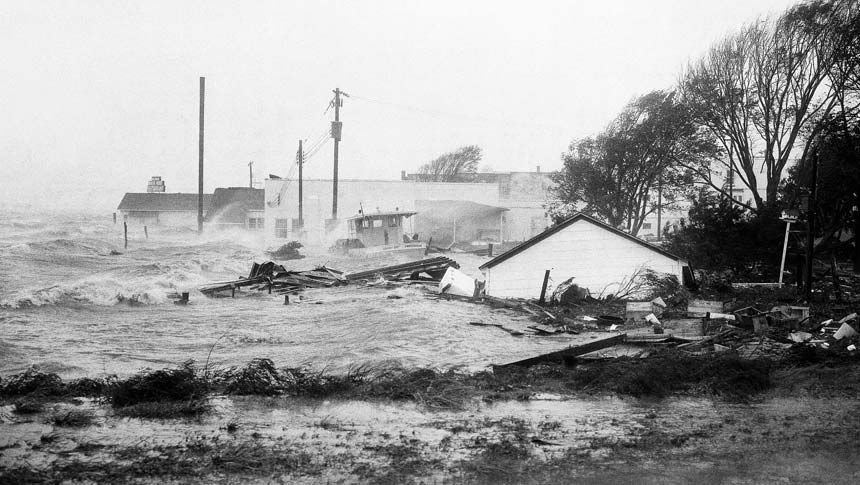1. Hurricane Hazel (1954)

Hurricane Hazel made landfall near the North Carolina - South Carolina border as a category 4 hurricane in October 1954. It is one of the most devastating natural disasters to affect the state of North Carolina. It killed 19 people in the state and injured around 200. An estimated 15,000 structures were completed destroyed. Another 39,000 structured suffered some sort of damage.
Estimated wind speeds during Hazel were as high as 125 to 150mph at Holden Beach, Oak Island, Calabash, and Wrightsville Beach. An 18 foot storm surge was reported at Calabash and Holden Beach.
Hazel accelerated in forward speed as it moved inland. Hurricane force winds were reported in Raleigh, Norfolk, and Washington DC.
2. Hurricane Floyd (1999)

Photo courtesy US Army Corp of Engineers.

Hurricane Floyd made landfall during the early morning hours of September 16, 1999 near Cape Fear, North Carolina as a category 2 storm. The heavy rains produced by the storm became a much bigger problem the the storm's wind for many inland communities. Around 15 to 20 inches of rain fell during the storm in eastern North Carolina.
About a week before Floyd hit, Tropical Storm Dennis produced heavy rain in the same areas impacted by Floyd. Many rivers and streams were already at flood stage. Floyd caused record flooding along some rivers in eastern North Carolina. Some communities were completely underwater for days. The flooding caused an estimated $6 billion in damage. Around 7000 were destroyed and another 17,000 were uninhabitable. 57 deaths were attributed to Floyd. 35 of those were in North Carolina.
3. Hurricane Hugo (1989)

Photo courtesy NOAA.

Hurricane Hugo is one of the strongest storms to ever hit the state of South Carolina. Even though the category 4 hurricane made landfall just north of Charleston, it still did extensive damage in North Carolina. Wind gusts of 100mph were reported in Charlotte.
Reports indicate 85% of homes and businesses in Charlotte lost power during Hugo as numerous trees and powerlines fell around the city. Skyscrapers in uptown Charlotte had large windows blown out by the powerful winds.
Millions of trees were reported down across the North Carolina Piedmont including in Gastonia, Lincolnton, and Hickory.
4. Hurricane Fran (1996)

Photo at North Topsail Beach courtesy NC Division or Marine Fisheries.

Hurricane Fran made landfall near Bald Head Island as a category 3 storm on the night of September 5, 1996. The storm produced wind damage well inland from the immediate coast as hurricane force winds were reported as far inland as Raleigh. At one point, 1.7 million customers were without power in North Carolina.
The storm killed 37 people with 24 of those in North Carolina. An estimated $2.3 billion in damage to homes and businesses in the state was reported.
5. Hurricane Matthew (2016)

Hurricane Matthew briefly made landfall near McClellansville, South Carolina on October 8, 2016. However, the storm's center never actually made landfall in North Carolina. The storm still did several millions of dollars in damage to eastern parts of the state and lead to several deaths.
Similar to Hurricane Floyd, Matthew's heavy rain caused more problems than its wind in many areas. Over a foot of rain fell during the storm in some parts of southeastern North Carolina including the Sandhills.




